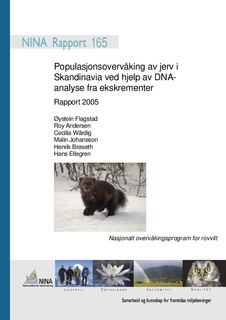Populasjonsovervåking av jerv i Skandinavia ved hjelp av DNA-analyse fra ekskrementer. Rapport 2005
Flagstad, Øystein; Andersen, Roy; Wärdig, Cecilia; Johansson, Malin; Brøseth, Henrik; Ellegren, Hans
Research report

Åpne
Permanent lenke
http://hdl.handle.net/11250/2375494Utgivelsesdato
2006Metadata
Vis full innførselSamlinger
- NINA Rapport/NINA Report [2341]
- Publikasjoner fra CRIStin - NINA [2364]
Originalversjon
Flagstad, Ø, Andersen, R., Wärdig, C., Johansson, M. Brøseth, H. & Ellegren, H. 2006. Populasjonsovervåking av jerv i Skandinavia ved hjelp av DNA-analyse fra ekskrementer – Rapport 2005. - NINA Rapport 165. 42 s.Sammendrag
Denne rapporten omhandler populasjonsovervåkningen av jerv ved hjelp av DNA-analyse fra
ekskrementer i sørlige deler av artens utberedelsesområde i Skandinavia. Rapporten fokuserer
i hovedsak på resultatene fra materiale som ble samlet inn i 2005, men sees også i sammenheng
med materiale fra 2000-2004 som er rapportert tidligere. I 2005 ble totalt 463 antatte
jervekskrementer samlet inn over hele Sør-Norge (inkludert Trøndelagsfylkene). I tillegg ble
152 prøver samlet inn i Jämtland og Dalarna. Vellykket genetisk analyse ble gjennomført på ca
55 % av innsamlet materiale.
De fungerende prøvene samlet inn på norsk side representerte 100 ulike individer. 79 av disse
dyra ble påvist i Sør-Norge, dvs fra Sør-Trøndelag og sørover. De resterende 21 ble funnet i
Nord-Trøndelag. De fungerende prøvene fra Jämtland og Dalarna representerte 46 ulike individer.
Av de 79 individene som ble påvist i Sør-Norge, var 53 representert i ekskrementmaterialet
fra tidligere års innsamlinger, som utgjør 2/3 av alle observerte individer. Ved
fangst/gjenfangst-metodikk er bestandsstørrelsen i Sør-Norge estimert til 90 individer i 2005
(95 % CI: 82-103). Bestandsestimatet basert på ekskrementanalysene holder seg altså stabilt
som de foregående årene i underkant av 100 individer. Estimatet basert på telling av aktive
ynglehi har derimot økt voldsomt de siste årene og er nå betydelig høyere enn det genetiske
estimatet. Stor mattilgang (smågnagerår) og økt sporingsinnsats de siste årene kan være med
på å forklare den dramatiske økningen i antall observerte ynglehi, uten at dette nødvendigvis
betyr at bestanden som sådan er økende.
Ved hjelp av de genetiske dataene har vi identifisert et distinkt skille mellom de østligste og de
mer sentrale delene av utbredelsesområdet i Sør-Norge. Jerv i den østlige delen av utbredelsesområdet
hører til samme delbestand som individer fra Jämtland, Dalarna og Nord-
Trøndelag, mens jerv vest for skillelinjen utgjør en genetisk vestlig delbestand i Sør-Norge.
Ved bruk av fangst/gjenfangst-metodikk er bestandsestimatet for den vestlige delpopulasjonen
69 individer, mens den østlige delpopulasjonen er estimert til 97 individer i 2005.
Tidligere har vi påpekt at forflytningen av dyr mellom de to delbestandene tilsynelatende har
vært asymmetrisk. Mens nesten alle dyr påvist i den østlige delbestanden syntes å ha foreldre
fra sin egen delbestand har vi opp gjennom årene funnet en god del individer i den vestlige delbestanden
som er meget sannsynlige immigranter fra øst. Analysen av fjorårets materiale kan
tyde på at den jevne strømmen av immigranter til den vestlige delbestanden er i ferd med å
avta (ingen nye immigranter ble observert i år), og at det asymmetriske migrasjonsmønsteret
er i ferd med å jevne seg ut eller snu. Det som imidlertid er helt klart er at vi fortsatt har et tydelig
mønster med to distinkte delbestander, og at den nåværende genflyten ikke synes å være
stor nok til å viske ut forskjellene mellom dem.
Jerv, Gulo gulo, ekskrementer, DNA, bestandsstørrelse, immigrasjon, Wolverine, faeces, DNA, population size, immigration This report describes DNA-based monitoring of the Scandinavian wolverine population, using scat samples collected in its southernmost distribution range. The results reported are mainly those obtained during 2005, but with reference to the results obtained in 2000-2004, summarized in previous reports.
In 2005, a total of 463 wolverine scatd were collected from southern and central Norway (including the counties of Nord-Trøndelag and Sør-Trøndelag). In addition, 152 scats were collected in the adjacent Swedish counties of Jämtland and Dalarna. DNA was successfully extracted from approximately 55 % of the scats.
A total of 100 individuals were identified from the Norwegian scats, 79 from Southern Norway (including Sør-Trøndelag), and the remaining 21 from Nord-Trøndelag. 46 individuals were observed in the two Swedish counties. Of the 79 individuals in Southern Norway, 53 had been identified in previous surveys, which is 2/3 of the observed individuals. Using a capture-mark-recapture model, the population size was estimated to 90 individuals (95% confidence intervals = 82-103) in 2005. This estimate is similar to what has been obtained the last years, and it seems that the population size is stable slightly below 100 individuals. In sharp contrast, the estimate based on the observed number of active natal dens has increased dramatically the last few years, and is now considerably higher than the genetic estimate. Food availability with
large populations of small rodents in recent years and increased tracking effort may partly explain the increased number of observed dens. However, it does not necessarily follow that the population size is increasing.
From the genetic data, we have identified two distinct sub-populations in Southern Norway, one to the east and north, and the other to the south and west. The northeastern sub-population includes individuals from Southern Norway east of Glomma, as well as individuals from Nord-Trøndelag, Dalarna and Jämtland. The southwestern sub-population includes all other areas in southern Norway. Using a capture-mark-recapture model, the population size was estimated to 69 individuals in the southwestern sub-population, whereas the northeastern sub-population was estimated
to 97 individuals in 2005.
Apparently, migration between the two areas is highly asymmetric. We have hardly detected any immigrants in the northeastern sub-population, whereas a substantial number of individuals appear to migrate from the north-east to the south-west. The updated analysis including material collected in 2005 may indicate that the steady migration rate from east to west is decreasing (no new immigrants were observed in 2005), and that the asymmetric migration pattern is becoming more symmetric or maybe even turn the opposite way. Still, however, the highly distinct genetic structure in Southern Scandinavia prevails, and the current gene flow does not seem to be high enough to erase the differences between the two sub-populations.